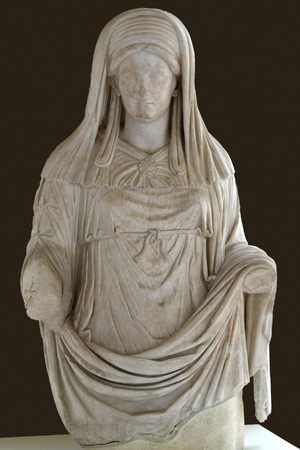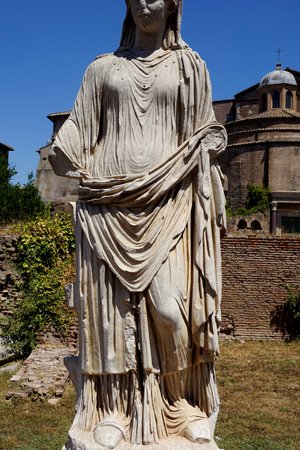Vestal Virgin
Vestal Virgins (Latin: virgo vestalis) were priestesses of the goddess Vesta in Ancient Rome. Vestal Virgins held a unique social status for women, standing higher in the hierarchy than most men and enjoying great respect and honor. Anyone who insulted a Vestal in any way could be sentenced to death. These women were freed from paternal authority, had the right to own and manage property, and were required to remain virgins until the end of their service; those who violated this taboo were executed.
Vestal Virgins were considered inviolable, which is why many entrusted them with the safekeeping of their wills and valuables. When a Vestal went out in public, she was always accompanied by a lictor who walked ahead of her, and she also had the right to ride in a chariot. If a Vestal encountered a criminal being led to execution, she had the authority to pardon him, indicating that Vestals may have held some administrative or governmental power.
The main duties of the Vestal Virgins included maintaining the sacred fire in the Temple of Vesta, ensuring the temple's purity, making offerings to Vesta and the Penates, and guarding the Palladium and other sacred objects. It is believed that they performed certain rituals, keeping their details secret from outsiders. The Vestal Virgins’ attire consisted of a long white tunic, with their heads covered by a special band (Latin: infula).
The Cult of Vesta
The institution of the Vestal Virgins is attributed to King Numa Pompilius, who organized the state religion into a system that remained in place until polytheism ceased to be the religion of Ancient Rome.
Livy described the service to Vesta, established by Numa, as follows: "He chose maidens to serve Vesta; this service came from Alba and was not foreign to the family of Rome's founder. To ensure they attended to the temple's affairs without interruption, Numa assigned them a salary from the treasury, and distinguished them with virginity and other signs of sanctity, granting them universal respect and inviolability."
Plutarch, also describing the cult of Vesta in Parallel Lives, did not address the important question of why only young girls were chosen as Vestals and why they had to maintain their chastity for 30 years. This requirement likely stems from older Latin traditions. Plutarch notes the similarity between the Roman and Greek rituals of maintaining an eternal flame, but in Greece, the fire was tended by older maidens, and if it went out, it could only be relit by the ancient method of igniting it from the sun. Plutarch attempted to logically connect the necessity of the priestesses' virginity with the "barrenness of fire." This belief may be explained by the primitive idea of "dedicating oneself to the deity"—a practice seen, for example, in the priests of the goddess Cybele or the Inca "Maidens of the Sun."
Initially, two Vestals were chosen—Gegania and Verenia—and later two more were added—Canuleia and Tarpeia. Eventually, Servius Tullius increased the number of Vestals to six, which remained the set number until the end.
When a vacancy arose in the college of priestesses, a new Vestal was chosen from among twenty girl candidates. Initially, this selection was made by Roman kings, but during the Republic and Empire, the High Pontiff made the selection by drawing lots.
Candidates for the Vestals were chosen based on the following criteria:
- They had to be of patrician origin;
- They had to be between the ages of 6 and 10;
- They could not have any physical defects;
- Both parents had to reside in Italy.
The new Vestal was brought into the atrium of the Temple of Vesta, where her hair was cut and hung as an offering on the sacred tree. Then, the young priestess was dressed entirely in white, given the name "Beloved" (Latin: Amata), which was added to her nomen, and informed about her new duties. According to Roman law, the chosen Vestals were removed from their family and placed under the protection of the High Pontiff. A girl could be released from her duty to serve Vesta only under special family circumstances.
The term of service to the goddess Vesta was 30 years. This period was divided into three equal parts: training, active service, and mentorship. After these years, a Vestal became free and could marry. However, this was extremely rare, as it was believed that a marriage to a former Vestal would not end well. The primary reason was that by marrying, a former Vestal would lose her unique status as a Roman woman and become an ordinary matron, completely dependent on her husband, which was obviously not in her best interest.
The Vestals were led by the eldest among them, known as the Great Vestal Virgin (Latin: Vestalis Maxima), who received instructions directly from the High Pontiff.
The main duty of the Vestals was to maintain the sacred fire on the altar of the goddess Vesta. The flame was extinguished once a year—on the first day of the New Year. It was then rekindled by the ancient method of rubbing wood against wood. The accidental extinction of the sacred fire was considered a bad omen, and if a Vestal allowed the fire to go out, she was whipped by the High Pontiff himself.
During the celebration of the first day of the New Year, the Great Vestal and the High Pontiff prayed for the well-being of Rome, ascending the Capitoline Hill. This ritual symbolizes the life of Rome and Roman civilization in Horace's famous ode Exegi monumentum: crescam laude recens, dum Capitolium scandet cum tacita virgine pontifex—“I shall rise fresh in praise, while the priest ascends the Capitoline with the silent maiden.”
The Vestals were very wealthy, mainly due to their ownership of extensive estates that generated significant income. Additionally, each Vestal personally received a considerable sum from her family upon her consecration. The Vestals also received generous gifts from emperors; for example, in 24 AD, when Cornelia joined the Vestals, Tiberius gave her 2 million sesterces.
However, there were also downsides to such a social status. If a Vestal violated her vow of chastity, she was sentenced to death. Since Rome could not commit the sacrilegious act of killing a Vestal, they were punished by being buried alive in the Campus Sceleratus (“Field of Crime”), located within the city near the Colline Gate on the Quirinal Hill. The Vestal was given a small supply of food, and this form of burial was technically not considered a death sentence. The seducer was beaten to death. The guilty Vestal was placed in a closed, strapped litter so that not even her voice could be heard, and she was carried through the forum. Everyone silently stepped aside and watched her pass with deep sorrow. There was no more terrifying sight for the city, no day more mournful than this. When the litter reached the designated place, slaves untied the straps. The High Priest recited a prayer, raised his hands to the sky before the execution, ordered the guilty to be led down into the underground chamber with a thick veil over her face, and then withdrew with the other priests. When the Vestal descended, the ladder was raised, the entrance was covered with a mound of earth, and the place of execution was made as smooth as the rest of the surface.
Notable Vestal Virgins
The priestesses of the goddess Vesta played a significant role in the fate of Rome. The records of the first known Vestals are semi-mythical:
- Rhea Silvia (Latin: Rhea Silvia)—mother of Romulus and Remus, the founders of Rome;
- Tarpeia (Latin: Tarpeia), who treacherously opened the city gates to the Sabines besieging Rome;
- Oppia, executed for impiety in 483 BC;
- Aemilia (Latin: Aemilia);
- Caecilia Metella;
- Licinia (Latin: Licinia)—sister of the consul Lucius Murena in 62 BC;
- Cornelia, the Senior Vestal, executed during the reign of Emperor Domitian;
- Aquillia Severa (Latin: Aquillia Severa), who married Emperor Elagabalus (Marcus Aurelius Antoninus);
- Coelia Concordia (Latin: Coelia Concordia), considered the last Great Vestal Virgin, died around 380 AD;
According to legend, two Vestals, Tuccia (Latin: Tuccia) and Claudia, were accused of breaking their vow of chastity but proved their innocence by performing miracles. Claudia pulled a ship deeply embedded in mud with a rope, and Tuccia was able to carry water in a sieve from the Tiber to the Forum.
Related topics
Woman in Ancient Rome, Pontifex
Literature
The Vestals // Encyclopedia of Brockhaus and Efron : in 86 volumes (82 volumes and 4 supplements).







